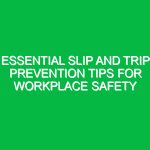In every workplace, the Safety of employees is paramount. Among the myriad of Safety concerns, slips, trips, and falls (STFs) stand out as leading causes of workplace injuries. A well-structured slips, trips, and falls safety talk is essential for ensuring that employees understand these Hazards and the measures to mitigate them. This article explores the critical aspects of STF safety talks within the context of Health, Safety, and Environment (HSE), providing actionable insights and guidelines that can enhance Workplace Safety.
Understanding Slips, Trips, and Falls
Slips occur when there is not enough friction between the footwear and the walking surface. Common causes include wet floors, spills, and uneven surfaces. Trips happen when an individual’s foot strikes an object, causing them to lose balance. This can be caused by clutter, loose mats, or uneven flooring. Falls are the result of losing balance and can lead to serious injuries, including fractures and concussions. According to the National Safety Council, falls account for over 30% of all non-fatal injuries in the workplace, making it crucial to address these risks effectively.
The Importance of Safety Talks
Conducting regular safety talks about slips, trips, and falls is not just a regulatory obligation; it is a proactive approach to Workplace Safety. Safety talks foster a culture of awareness and precaution, encouraging employees to be vigilant. They also serve as a reminder of the organization’s commitment to health and safety, reinforcing the idea that everyone plays a role in maintaining a safe work environment.
Key Components of an Effective Slips, Trips, and Falls Safety Talk
1. Identifying Hazards
The first step in any safety talk is identifying potential hazards. Employees should be encouraged to report hazards they observe, such as wet floors or cluttered walkways. Regular inspections can help identify areas where slips, trips, and falls might occur. For instance, a Maintenance crew might notice that a particular area of the floor becomes slippery when wet. Addressing these hazards promptly can prevent accidents.
2. Implementing Control Measures
Once hazards are identified, it is vital to discuss Control Measures. These may include:
- Using slip-resistant mats in areas prone to spills.
- Ensuring proper lighting in all work areas.
- Implementing regular cleaning schedules to eliminate spills or debris.
- Encouraging the use of appropriate footwear.
By taking these measures, organizations can significantly reduce the risk of slips, trips, and falls.
3. Training and Awareness
Training sessions should focus on educating employees about Safe Practices. For example, employees should learn the proper way to lift objects without losing balance or how to navigate around obstacles. Regular Training sessions can keep safety at the forefront of employees’ minds. Anecdotal evidence from a manufacturing facility showed that after implementing monthly safety talks, incidents of STFs decreased by over 40% in just six months.
4. Encouraging Reporting and Feedback
Creating an environment where employees feel comfortable reporting hazards is crucial. Feedback mechanisms, such as suggestion boxes or anonymous reporting, can encourage this behavior. When employees see that their reports lead to tangible improvements, they are more likely to engage in safety practices actively.
5. Emergency Preparedness
Finally, safety talks should include instructions on what to do in the event of a slip, trip, or fall. This includes knowing how to report the incident, administering first aid, and ensuring that emergency contacts are readily available. Having clear protocols can help reduce confusion and panic during an actual incident.
Real-Life Examples and Case Studies
One notable example of effective STF safety talk implementation comes from a large construction project in New York City. The project manager initiated weekly safety briefings that specifically addressed slips, trips, and falls. They encouraged workers to voice their concerns, leading to the identification of Hazardous Areas. Over the course of the project, injuries related to slips, trips, and falls decreased significantly, demonstrating the value of ongoing dialogue around safety.
In contrast, a retail chain that did not prioritize STF safety talks experienced a series of slip-related injuries. The lack of awareness among employees about the risks associated with wet floors led to multiple claims and increased insurance costs. After restructuring their safety talks to include practical demonstrations and real-life scenarios, they saw a marked decrease in incidents over the following year.
Regulations and Standards Governing STF Safety
Various Regulations govern Workplace Safety concerning slips, trips, and falls. The Occupational Safety and Health Administration (OSHA) provides guidelines that mandate employers to maintain a safe work environment. Specific standards, like those addressing walking-working surfaces, require that employers ensure surfaces are free from hazards, well-lit, and maintained in a safe condition.
Moreover, the National Institute for Occupational Safety and Health (NIOSH) promotes research and recommendations to prevent falls in the workplace. Employers must stay informed about these regulations and ensure compliance to avoid penalties and, more importantly, to protect their employees.
Best Practices for Conducting Slips, Trips, and Falls Safety Talks
1. Make it Interactive
Encourage participation during safety talks. Include question-and-answer sessions and scenario-based discussions. When employees engage in the conversation, they are more likely to retain the information shared.
2. Use Visual Aids
Incorporating visual aids, such as videos, slides, or even physical demonstrations, can enhance understanding. For instance, showing a video of common slip and trip scenarios can help employees visualize hazards they may encounter on the job.
3. Tailor Content to Specific Work Areas
Different workplaces have unique hazards. Tailoring safety talks to address specific risks relevant to the work environment can make discussions more meaningful. For instance, a talk in a warehouse may focus on the hazards of moving equipment and pallet jacks, while an office setting may emphasize the importance of maintaining clear walkways.
4. Follow Up
After conducting a safety talk, always follow up. Check in with employees to see if they have noticed any improvements or if further issues have arisen. This demonstrates that safety is an ongoing commitment and encourages continuous dialogue.
Conclusion
The significance of a well-structured slips, trips, and falls safety talk cannot be overstated in the HSE context. By focusing on identifying hazards, implementing control measures, providing training, and encouraging reporting, organizations can cultivate a culture of safety. Real-life examples illustrate that proactive approaches can lead to significant reductions in accidents, protecting both employees and the organization’s bottom line.
As we navigate through the complexities of Workplace Safety, let us remember that every employee has a role to play. By fostering open communication and awareness, we can work together to create a safer environment for everyone. It is not just about compliance; it is about caring for the well-being of our colleagues and ensuring a sustainable work environment.


